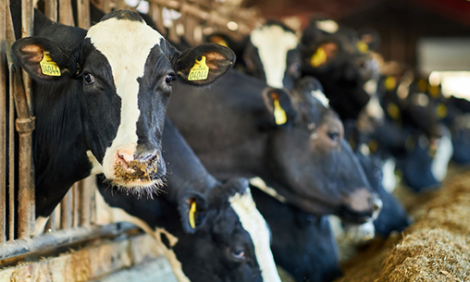



Your Herd's Reproductive Status
By Raymond L. Nebel, Extension Dairy Scientist, Reproduction, and Professor of Dairy Science, Virginia Tech. Table of Contents
Table of ContentsIntroduction
Management Policy
Heat Detection
Conception Rate
Herd Health
Summary
Introduction
Maintaining a high level of reproductive efficiency is required if dairy herd profitability is to be maximized. Reproductive performance of a dairy herd is a function of certain management policies and how well these management policies are implemented in the day-to-day management of the herd.The first step in evaluating the reproductive performance is to identify key measurements and use them as guides in developing or altering herd management policies and practices. The calving interval should be the starting point in evaluation of prior herd performance. For maximum production, a calving interval of 12.3 to 12.8 months must be achieved. When calving intervals vary beyond this range, milk production drops significantly, with a sharp drop when calving intervals exceed 13.6 months. To assess why long calving intervals exist, one must evaluate performance in four areas: (1) management policy and philosophy; (2) heat detection; (3) conception rate; and (4) herd health. These areas are not mutually exclusive, but it is most efficient to deal with these individually. Outlined in Table 1 are realistic management goals for Days Open that should be used as benchmarks in evaluation of your herd's reproductive performance. Knowing the strengths and weaknesses of the reproductive program will indicate what kind of management decisions may be most profitable.
| Table 1. Interpretation of various levels for days open | |||||
| Level | Interpretation | ||||
|
85 to 110
|
Excellent | ||||
|
111 to 117
|
Adequate Efficiency | ||||
|
118 to 130
|
Slight Problem | ||||
|
131 to 145
|
Moderate Problem | ||||
|
Over 145
|
Severe Problem | ||||
Management Policy
Reproductive performance in a herd is affected by various policies set by management. Managers who recognize the importance of good performance usually have an understanding of the losses in potential income that occur when calving intervals are too long and when reproductive culling rates are too high. They are therefore motivated to develop and maintain an effective reproductive management program.Good reproduction management begins during the dry period. Cows that experience problems at calving and cows that are in a severe negative energy balance after calving will be slower to resume cycles. Reproductive problems are rarely sudden in appearance and they are rarely due to a single cause. One of the best measures of how management policy affects reproductive performance is reflected in the interval from calving to first breeding. Table 2 gives an interpretation of various intervals from calving to first breeding and the effectiveness of management practices in the area of reproductive performance of the herd.
| Table 2. Interpretation of various intervals for days to first breeding | |||||
| Level | Interpretation | ||||
|
60 to 75
|
Excellent | ||||
|
76 to 82
|
Adequate Efficiency | ||||
|
83 to 90
|
Slight Problem | ||||
|
91 to 100
|
Moderate Problem | ||||
|
Over 100
|
Severe Problem | ||||
Heat Detection
Good heat detection is the single most important factor in shortening the calving interval. Greater emphasis should be placed on detecting early heats (before 50 days) on all cows so as to anticipate subsequent heat periods. All cows not detected in heat by 50 days should be watched closely and examined by a veterinarian to determine if the uterus is infected or if the ovaries are inactive or cystic. Special attention should be given cows with post-calving problems and cows bred three or more times. Knowledge of the percentage of breedable heats is essential in evaluating the heat detection program. For all DHI members, the percentage of breedable heats detected can be evaluated by using the "Yearly Reproductive Summary" information of the DHI-202 form under the column "percent of possible heats observed" (average for entire year). Table 3 should be used as a guideline for interpreting your heat detection efficiency as measured by the percent of possible breeding detected as reported by DHI. If you are not a DHI member, the number of breedable heats can be evaluated by this formula:
This formula assumes that the first breedable heat beyond a 45 day waiting period would be detected on the average at day 55 postpartum. The percentage of breedable heats detected can then be estimated by this formula:
Heat detection rates can be increased if dairymen (1) recognize factors that affect expression of heat, (2) record all observed heats and use records in predicting subsequent heats, (3) use heat detection aids carefully, and (4) know the percentage of breedable heats detected (DHI).
| Table 3. Interpretation of levels of heat detection efficiency | |||||
| Level | Interpretation | ||||
|
Over 71
|
Excellent | ||||
|
61 to 70
|
Adequate Efficiency | ||||
|
51 to 60
|
Slight Problem | ||||
|
41 to 50
|
Moderate Problem | ||||
|
Under 40
|
Severe Problem | ||||
Conception Rate
This is a broad category when evaluating reproductive records. Conception rate at first breeding provides a useful estimate of the conception rate for a herd. However, it is a measurement that combines the effects of semen quality, fertility of the cow, timing of insemination, semen handling and insemination techniques, as well as factors such as high environmental temperature and stress. Breedings per conception should be interpreted according to the guidelines in Table 4.| Table 4. Relationship between breedings per conception and level of fertility | |||||
| Level | Interpretation | ||||
|
Under 1.8
|
Excellent | ||||
|
1.8 to 2.0
|
Adequate Efficiency | ||||
|
2.0 to 2.3
|
Slight Problem | ||||
|
2.3 to 2.8
|
Moderate Problem | ||||
|
Over 2.8
|
Severe Problem | ||||
Herd Health
Reproductive performance of a dairy herd is affected by its overall health. Good sanitation and vaccination programs can prevent many infections or diseases that lower reproductive performance. The effects of disorders on reproductive performance, culling, and profit are more severe in older cows. Cows that are assisted at calving or are treated for retained placenta are at increased risk to suffer additional disorders (uterine infections and cystic ovaries). Therefore, the key to preventing losses due to reproductive disorders must be found in the prevention of such disorders, not in their treatment.Summary
Most dairymen can improve production and net income substantially by improving the reproductive performance of their dairy herd. However, before evaluation of the reproductive status can be made, some yardsticks to measure reproductive efficiency must be established.June 1998



